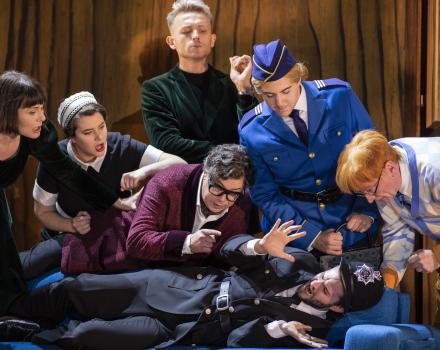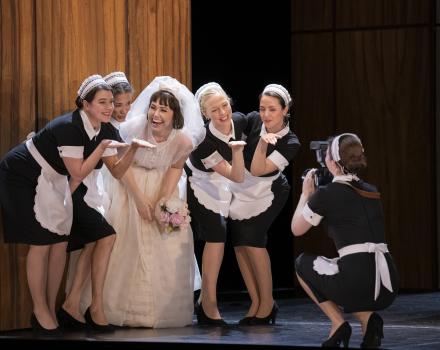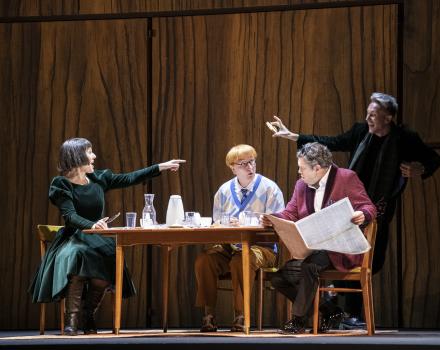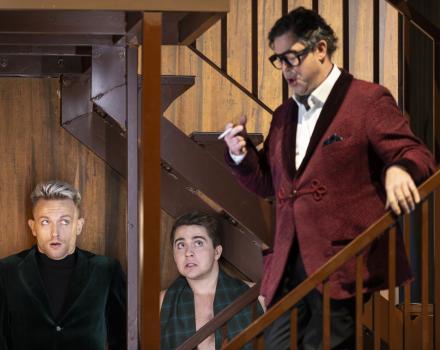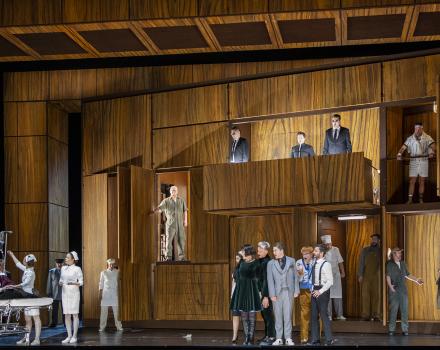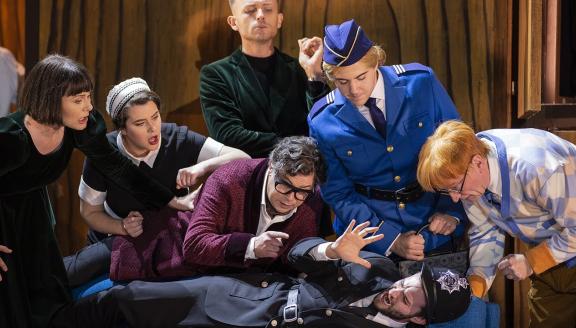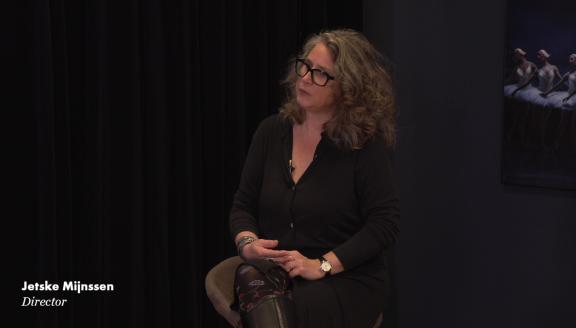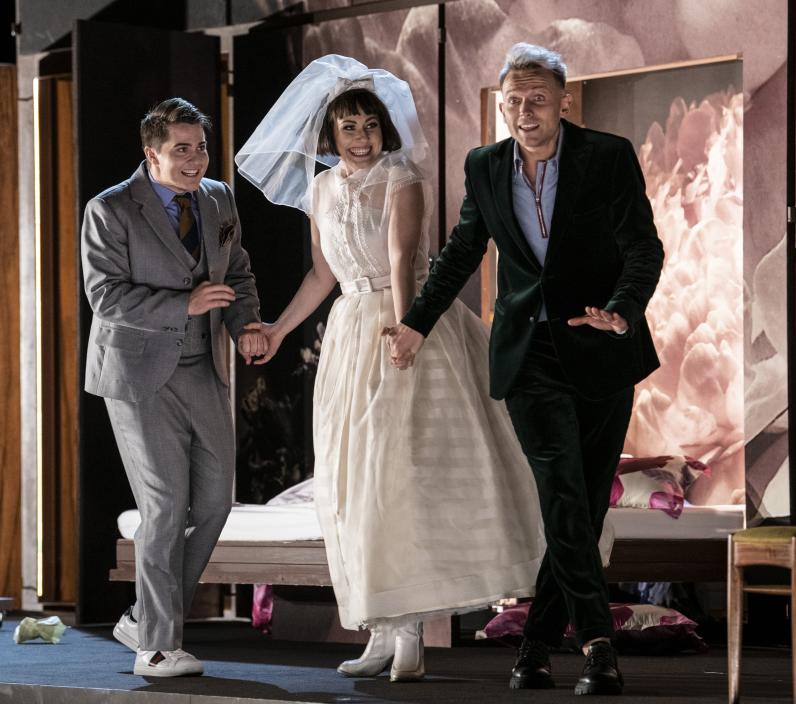

A young count is in love with a shrewd woman who returns his feelings. But her guardian harbours his own plans for her. When jack-of-all-trades Figaro rushes to the young couple's aid, bribery, deceit and comic entanglements ensue. Will he succeed in saving the day - and love?
Bursting with exuberant music, captivating comedy and ingenious disguises, Rossini’s masterpiece is the ultimate feel-good opera. In Den Norske Opera and Ballett’s new production, director Jetske Mijnssen takes the story seriously - didn’t Count Almaviva and Rosina’s union turn out unhappy in Mozart’s The Marriage of Figaro? - and shows how comedy is always close to tragedy.
Cast
|
Figaro
|
Hubert Zapiór
|
|---|---|
|
Rosina
|
Angela Brower
|
|
Grev Almaviva
|
Jack Swanson
|
|
Dr. Bartolo
|
David Stout
|
|
Berta
|
Renate Ekerhovd
|
|
Basilio
|
Clive Bayley
|
|
Fiorello
|
Magnus Ingemund Kjelstad
|
|
Chorus
|
Den Norske Opera chorus (men)
|
|
Orchestra
|
Den Norske Opera's orchestra
|
| ... | |
|
Music
|
Gioachino Rossini
|
|---|---|
|
Conductor
|
Tobias Ringborg
|
|
Director
|
Jetske Mijnssen
|
|
Sets
|
Herbert Murauer
|
|
Lighting
|
Mark Van Denesse
|
|
Costumes
|
Julia Katharina Berndt
|
|
Text
|
Cesare Sterbini (based on Pierre Beaumarchais' drama)
|
| ... | |
Video
The story
Act I
In Seville, Count Almaviva wants to marry Rosina. He has disguised himself as a poor student in the hope that she will fall in love with him unconditionally rather than for his title or money. Rosina lives with the much older Doctor Bartolo, her guardian, who wants to marry her himself as soon as possible and receive her dowry. The Count serenades Rosina outside her window, but she fails to appear on her balcony. Figaro, the local barber, recognises him and offers to help. He tells the Count to pretend to be a drunken soldier and demand to stay at Bartolo’s house. That way he will be able to get close to Rosina.
Inside the house, Rosina writes a letter to the student she heard outside her window. Don Basilio, her music teacher, tells Bartolo that he should be suspicious of Rosina and the Count. When the latter arrives in his disguise, he passes a love letter to Rosina and whispers that he is in fact the student who serenaded her. Bartolo suspiciously demands to know what is in the piece of paper, but Rosina fools him by handing over her laundry list instead. Bartolo and the Count argue loudly, the noise attracting the attention of the Police Sergeant and his officers, who crowd into the room. Bartolo demands that they arrest the drunken soldier, but Almaviva quietly reveals his true identity to the Sergeant, who then stands down, causing complete chaos and utter confusion.
Act II
Count Almaviva appears at Bartolo's door, this time disguised as a priest. He tells the doctor that he is also a singing tutor and has come to replace the suddenly ill Don Basilio in teaching Rosina. Bartolo is suspicious but allows the lesson to take place under his supervision. Figaro arrives to shave Bartolo’s beard, distracting him enough for the Count and Rosina to declare their mutual love and plan their escape. When Basilio turns up, the Count tries to bribe him into leaving and comments on how sickly he looks. But Bartolo smells a rat and asks Basilio to summon the notary so that he can marry Rosina immediately.
During a storm, the Count and Figaro climb a ladder to Rosina’s bedroom to take her away. But as they are about to escape, they find that the ladder has disappeared. Hearing footsteps approaching, Figaro gives Basilio an offer he can’t refuse, forcing him to witness the marriage between Rosina and Almaviva. Bartolo barges in but it is too late, the marriage contract has been signed. Receiving Rosina’s dowry in compensation, he reluctantly accepts the situation and joins in as everyone sings an anthem to love.
Insights
No happy ending
Ever since director Jetske Mijnssen first staged The Barber of Seville 10 years ago, she has had a problem with the opera. Quite simply, she does not find the end credible. There is a good reason for that, if you know the background history.
To understand the end, we have to start at the beginning: The playwright Pierre-Augustin Beaumarchais wrote the political and comic trilogy The Barber of Seville, The Marriage of Figaro and The Guilty Mother between 1782 and 1792. The plays follow Count Almaviva, Figaro and Rosina (later Countess Almaviva), Doctor Bartolo and Don Basilio through their lives in a series of intrigues and entanglements. However, there is one thing that remains constant:
‘They are all fairly unreliable and unlikeable, if you ask me’, says director Mijnssen.
The family that is not a family
‘The characters we meet act as a strange, dysfunctional family, even though they are not actually related. We have this doctor, who is not necessarily a doctor, who would really just like to drink his coffee and read his newspaper in peace. We have the music teacher, Don Basilio, who as a sensitive soul is slightly out of place there, while Figaro and Rosina are like two bickering teenage siblings teasing each other at the breakfast table. In a strange way, they all belong together in this landscape.’
But for Mijnssen it is not about getting us to like them. She maintains that they are all greedy and wilful:
‘The most important thing about this opera is that they are all unpleasant people. Even Rosina. I know that she tends to be regarded as a victim of her time, because she is kept locked up by Doctor Bartolo and is about to be forced into marriage. But I see her as a scheming woman, full of her own conspiracies, who uses the count to get away from Bartolo.’
However, a rule always has an exception.
‘Berta. In the original version, she is an old housekeeper, but in our version she is young and madly in love with Figaro. She also mainly thinks of herself, but in the end she is probably the nicest person on the stage.’
Back to the beginning
It was Mozart who first turned Beaumarchais’ second play into an opera, The Marriage of Figaro. The year was 1786, and the opera became an instant success.
Thirty years later, in 1816, Giacomo Rossini decided to make an opera out of the forerunner of Mozart’s masterpiece. The Barber of Seville was written the way the music sounds: effervescent and bubbling with ideas. Rumour has it that Rossini spent between 13 and 19 days on the entire work.
In The Marriage of Figaro, the audience of the 19th century had got to know Count Almaviva as a real philanderer. In The Barber of Seville, when they met the younger version of the count, who still had an aura of innocence, many people saw him in light of The Marriage of Figaro – all that glitters is not gold. But nowadays we are not guaranteed to view the count in The Barber of Seville with the same healthy scepticism. And that is where Jetske Mijnssen’s problem starts.
‘I don’t believe the ending the way it is written, and I don’t think anyone can. The opera ends with Rosina, Figaro and Count Almaviva succeeding in fooling the grumpy old Doctor Bartolo, who had tried to marry Rosina against her will. The three bold young people seem to be getting their revenge on the bad-tempered old man. Is this commedia dell’arte portrayal of three young heroes and the grumpy old man still relevant for us? Well, it isn’t the story I want to tell’, says Mijnssen.
And that is why she sat down and listened again. Of course Rossini knew this about Count Almaviva – so was there anything in the music that showed his true colours?
‘There is an aria at the very end of this opera that is almost always cut. It’s called ‘Cessa di più resistere’ and it’s different from the rest – it’s a showstopper. When I put on The Barber of Seville 10 years ago, it went straight out, because I thought: What?! Will the count sing for eight minutes at the end of the opera? No way!’ Mijnssen laughs.
But now she has listened to the aria with new ears.
‘This is an amazing number, a bravura aria, but as a director you must have a specific idea about it if it is going to work. So I listened to the count boast of his love for Rosina (they are about to get married) while he’s actually boasting about himself. But then … he loses it completely in the marvellous coloraturas. My first thought was: This is the count I know. This is the count from The Marriage of Figaro.’
Mijnssen calls it an expression of his superficial personality, perfect for the womaniser that the count is going to become. The aria thereby breaks up the happy ending and bridges the gap to The Marriage of Figaro.
The comedy’s success
Bringing in ‘Cessa di più resistere’ is a perfect illustration of Mijnssen’s work as a director. It’s about taking the work seriously in more than one way.
‘If you’re going to do comedy right, you have to take the framework seriously. The more seriously the singers take it, the funnier it gets. The first time I did The Barber of Seville, I didn’t rely on the material. I tried to find a new framework and situations for the piece. Now I want to rely on the material, focus on what is between all these unlikeable people, who for some strange reason all collide in Doctor Bartolo’s mansion.’
It’s traditional to treat The Barber of Seville as a farce. The consequence, according to Rossini biographer Richard Osborne, is that the characters have been reduced to a kind of puppet. And if you ask Jetske Mijnssen, they are far from one-dimensional.
‘The most important quality of any good comedy is that in the end, it hurts. These people remind us of our own weaknesses. It’s like in the comic opera Don Pasquale: It’s painful to see the old man believing that he can be happy with a young woman. It’s painful when everything collapses.’
Text: Vilde Alette Monrad-Krohn
Gallery
